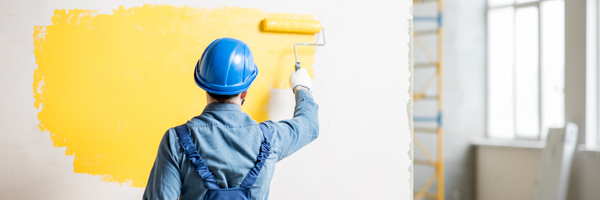
Risk assessment for painting contractors is essential to enhance workplace safety for painting. Without a proper painting contractors risk management plan, hazardous conditions around your job site can occur.
We’re here to help you recognize painting hazards and risks that can lead to painting insurance claims without proper safety protocols. With the right equipment, safety practices and contractors risk management, it’s easy to increase protection and reduce potential loss or injury on job sites.
What are hazards of painting?
Painting contractors face unique risks that can impact safety on a worksite. Here are some of the most common painting hazards:
-
Presence of harmful substances.
Mold, asbestos, bacteria, fungi and lead are all dangerous substances to touch or ingest. It’s essential for painters or other certified professionals take the appropriate steps to isolate themselves, wear appropriate personal protective equipment or remove harmful substances before painting can begin.
-
Poor ventilation inside buildings.
Without proper ventilation, paint vapors can cause irritation in your eyes, nose and throat. You can also experience nausea, trouble breathing or lightheadedness. In extreme cases, your kidney, liver and nervous system can be damaged from highly concentrated vapors. Wear a paint mask or respirator for ample protection.
-
Improper preparation of job site.
It is up to painting contractors and the businesses who hire them to work together in preparation of the job site. Expectations should be set and proper steps followed to avoid painting hazards and claim risks.
-
Heat and cold exposure.
Interior painting requires dry, temperature-controlled spaces for paint to set and dry properly. This can also help reduce the likelihood of mold or bacteria growth from excessive moisture. When painting outdoors, follow OSHA's guidance on how to safely work in hot or cold weather.
It is up to painting contractors to be familiar with painting hazards and control measures so they can increase safety for everyone.

Learn about our
Business Insurance
Equipment for reducing painting hazards and risks
The right equipment can help reduce contractor risks for injury or damage during indoor painting. Painting contractors should have:
- Personal protective equipment such as safety glasses, gloves, respirators or paint masks and white coveralls to protect your body while you work.
- Additional personal protective equipment needed for stripping paints, removing asbestos, removing lead, or eliminating other harmful substances. For example, an electric sander with a filtered vacuum can help strip paint.
- Sturdy ladders, suitable footwear, hard hat and harness for painting tall or hard-to-reach areas and moving between platforms and secure scaffolds safely.
Lastly, take electrical precautions for removing switch plates and outlet covers. Turn off the electricity and either rely on good natural lighting or portable work lights for safe indoor painting.
Common insurance claims for painting contractors
Now you know some of the most common painting hazards and equipment that can increase painting safety. There are common claims you should be aware of and try to avoid. When risk assessment for painting contractors falls through the cracks, you might need to file a claim for:
- Trips and falls, particularly from a ladder
- Paint spills
- Slips on drop cloths
- Broken windows
- Inhaling vapors
- Overextension or injury from heavy equipment
Keep these common claims in mind to keep safe painting practices top of mind and avoid injury, damage and painting insurance claims.
Create a plan for safe outdoor and indoor painting
Painting contractors can work with their risk control team to create a contractors risk management plan to fit their needs. This plan should include OSHA requirements for setting up a job site, painting, tearing down and disposing of leftover paint. Most contractor risk assessment plans should also include OSHA requirements for construction site safety.
It is essential for painting contractors to be knowledgeable about best practices for working near falling objects, proper lifting techniques, selecting and wearing personal protective equipment and other painting tasks.
Painters should also know how to maintain equipment in good working condition, work in confined spaces safely, clear clutter and assess a job site periodically to ensure it is secured from painting hazards.
For more information about safety training for painters, avoiding painting hazards or to learn how you can complete a contractors risk assessment, talk to your Grange Risk Control team.
This article is for informational and suggestion purposes only. Implementing these suggestions does not guarantee coverage. If any policy coverage descriptions in this article conflict with the language in the policy, the language in the policy applies. For full details on Grange’s business insurance coverages and discounts, contact your local independent agent.
References
OSHA
Healthline
OSHA Construction
Safety by Design